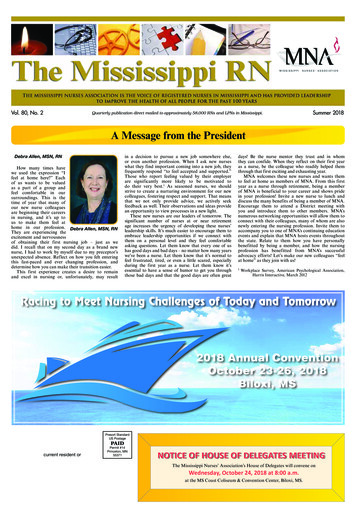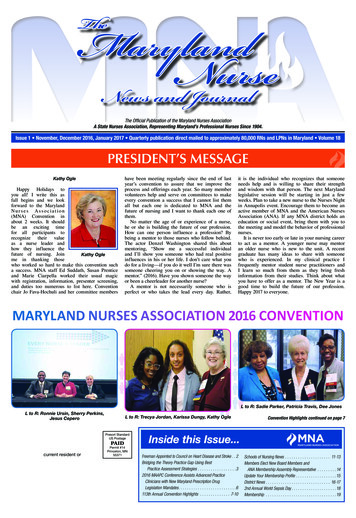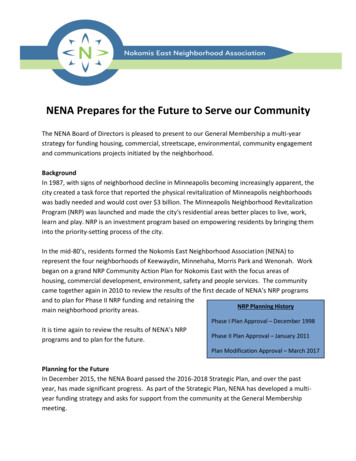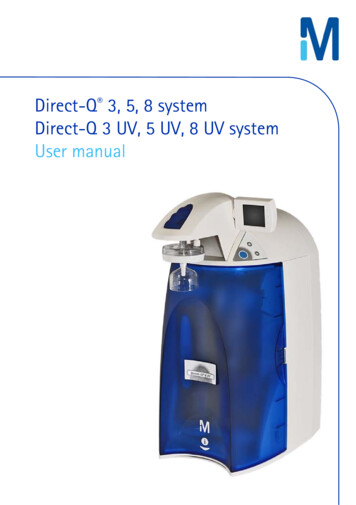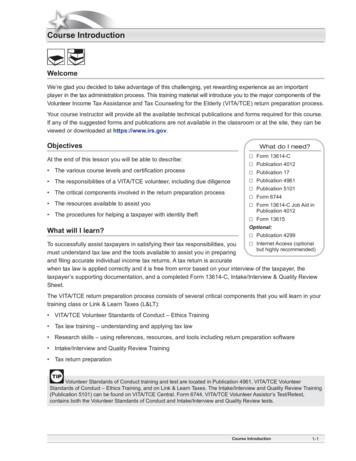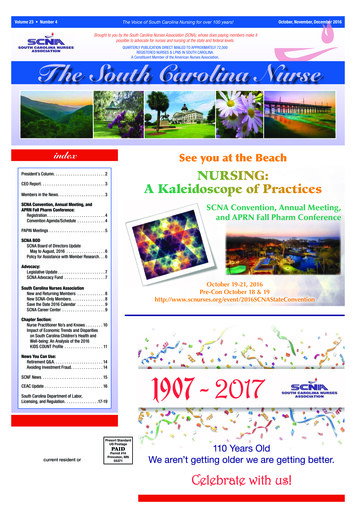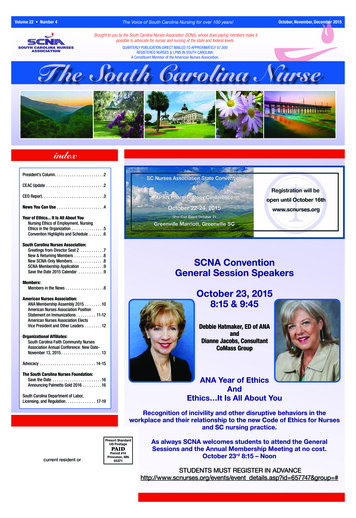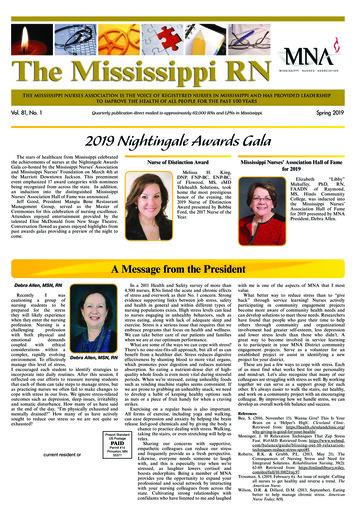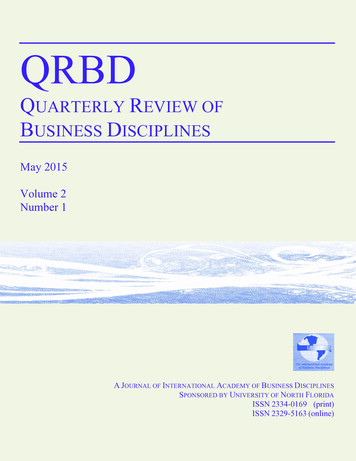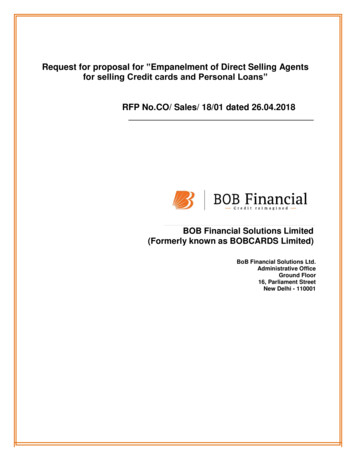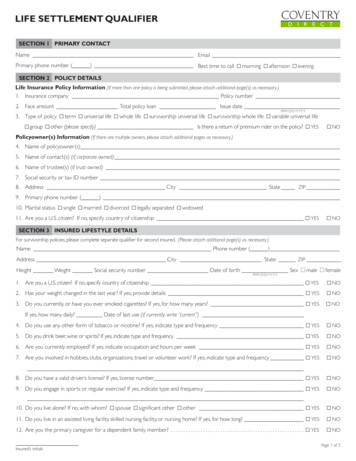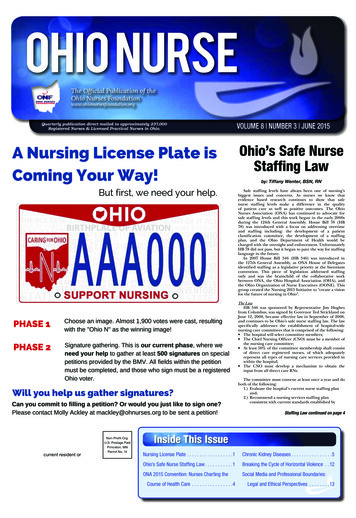
Transcription
Quarterly publication direct mailed to approximately 237,000Registered Nurses & Licensed Practical Nurses in Ohio.VOLUME 8 NUMBER 3 JUNE 2015Ohio’s Safe NurseStaffing Lawby: Tiffany Wenter, BSN, RNSafe staffing levels have always been one of nursing’sbiggest issues and concerns. As nurses we know thatevidence based research continues to show that safenurse staffing levels make a difference in the qualityof patient care as well as positive outcomes. The OhioNurses Association (ONA) has continued to advocate forsafe staffing levels and this work began in the early 2000sduring the 124th General Assembly. House Bill 78 (HB78) was introduced with a focus on addressing overtimeand staffing including: the development of a patientclassification committee, the development of a staffingplan, and the Ohio Department of Health would becharged with the oversight and enforcement. UnfortunatelyHB 78 did not pass, but it began to pave the way for staffinglanguage in the future.In 2007 House Bill 346 (HB 346) was introduced inthe 127th General Assembly, as ONA House of Delegatesidentified staffing as a legislative priority at the bienniumconvention. This piece of legislation addressed staffingonly and was the brainchild of the collaborative workbetween ONA, the Ohio Hospital Association (OHA), andthe Ohio Organization of Nurse Executives (OONE). Thisgroup created the Nursing 2015 Initiative to “create a visionfor the future of nursing in Ohio”.The LawHB 346 was sponsored by Representative Jim Hughesfrom Columbus, was signed by Governor Ted Strickland onJune 12, 2008, became effective law in September of 2008,and continues to be Ohio’s safe nurse staffing law. The lawspecifically addresses the establishment of hospital-widenursing care committees that is comprised of the following: The hospital will select committee members; The Chief Nursing Officer (CNO) must be a member ofthe nursing care committee; At least 50% of the committee membership shall consistof direct care registered nurses, of which adequatelyrepresent all types of nursing care services provided inwithin the hospital; The CNO must develop a mechanism to obtain theinput from all direct care RNs.The committee must convene at least once a year and doboth of the following:1.) Evaluate the hospital’s current nurse staffing planand;2.) Recommend a nursing services staffing planconsistent with current standards established byStaffing Law continued on page 4current resident orNon-Profit Org.U.S. Postage PaidPrinceton, MNPermit No. 14Inside This IssueNursing License Plate. . . . . . . . . . . . . . . . . . 1Chronic Kidney Diseases. . . . . . . . . . . . . . . . 5Ohio's Safe Nurse Staffing Law. . . . . . . . . . . 1Breaking the Cycle of Horizontal Violence . . 12ONA 2015 Convention: Nurses Charting theSocial Media and Professional Boundaries:Course of Health Care . . . . . . . . . . . . . . . . 4Legal and Ethical Perspectives . . . . . . . . 13
Page 2Ohio NurseSAVE THE DATEJune 2015Free IndependentStudiesJune 16, 2015July 22, 2015Summer SeriesSpeaker: Pam DickersonONA HeadquartersColumbus, OHJuly 15, 2015October 21, 2015Becoming An Approved Provider – 2015ONA HeadquartersColumbus, OHOctober 8-11, 2015ONA ConventionVisit ohnurses.org/eventsfor more information.OHIO NURSEThe official publication of the Ohio NursesFoundation, 4000 East Main St., Columbus, OH43213-2983, (614) 237-5414.Web site: www.ohionursesfoundation.orgAll independent studies publishedin the Ohio Nurse are FREE to ONAmembers for three months andcan also be completed online atwww.CE4Nurses.org/ohionurse.Non-members can also complete thestudies published in this issue online for 12 per study or by mailing in the testsprovided for 15 per study. See page 3for more details.Interested in joining ONA? See page3 for membership information and fivereasons for joining the only professionalorganization in Ohio for registerednurses.Articles appearing in the Ohio Nurse are presented forinformational purposes only and are not intendedas legal or medical advice and should not be used inlieu of such advice. For specific legal advice, readersshould contact their legal counsel.ONF Board of DirectorsOfficersDavina Gosnell,ChairKentBarb Welch,DirectorRushvilleLori Chovanak,CEO/PresidentColumbusDiane Winfrey,DirectorShaker HeightsJill Frey,SecretaryHamiltonSusan Stocker,DirectorHamiltonKathryn Peppe,TreasurerColumbusElaine Mertz,DirectorCridersvilleDaniel Kirkpatrick,DirectorFairbornwww.ohnurses.orgThe Ohio Nurse is published quarterly in March, June,September and December.Address Changes: Send address changes toLisa Walker, lwalker@ohnurses.org / 614-448-1031.EARTH is our favorite planet.Let’s keep it.Sprint is committed to environmental leadership.Join us in our efforts for a sustainable future.Visit sprint.com/recycle.Earn extra cash for your devices with theSprint Buyback program.Published by:Arthur L. DavisPublishing Agency, Inc.RN CARE COORDINATOR POSITIONS AVAILABLEIn this role you will provide intake, assessment, and monitor all aspectsof care and consumer services, & ensure the needs of consumers andcaregivers are met. Applicants must be an RN with at least one year ofexperience. Reliable transportation to travel to complete home visits isalso a must. These positions offer a competitive salary, work from homeopportunities and opportunity for flexible scheduling. Please contact:John Jones, email jjones@help4seniors.org or visit our website at www.help4seniors.org and click on the career opportunities link.ChillicotheVA Medical CenterWe provide acute and chronic mental healthservices, primary and secondary medical services,a wide range of nursing home care services, specialtymedical services as well as specialized women Veteranshealth clinics. The facility is an active ambulatory caresetting and serves as a chronic mental health referral centerfor VA Medical Centers in southern Ohio and parts ofWest Virginia and Kentucky.Currently seeking:Psychiatric, Palliative Care, and Primary CareNurse Practitioners - Experience PreferredBenefits include up to five weeks vacation per year, sick leave accrual,federal retirement plan, thrift savings plan (similar to a 401K account)Contact: Eric CepekHuman Resources Specialist (O5Q)Chillicothe VA Medical Center17273 State Route 104, Chillicothe, OH. 45601-9718E-mail eric.cepek@va.govwww.chillicothe.va.govEOEFor advertising rates and information, pleasecontact Arthur L. Davis Publishing Agency, Inc., 517Washington Street, PO Box 216, Cedar Falls, Iowa50613, (800) 626-4081, sales@aldpub.com. ONF andthe Arthur L. Davis Publishing Agency, Inc. reservethe right to reject any advertisement. Responsibilityfor errors in advertising is limited to corrections inthe next issue or refund of price of advertisement.Acceptance of advertising does not implyendorsement or approval by the Ohio NursesFoundation of products advertised, the advertisers, orthe claims made. Rejection of an advertisement doesnot imply a product offered for advertising is withoutmerit, or that the manufacturer lacks integrity, or thatthis Foundation disapproves of the product or its use.ONF and the Arthur L. Davis Publishing Agency, Inc.shall not be held liable for any consequences resultingfrom purchase or use of an advertiser’s product.Articles appearing in this publication express theopinions of the authors; they do not necessarily reflectviews of the staff, board, or membership of ONF.
June 2015Ohio NurseJoin theOhio NursesAssociationPage 3Registration Form:Select the studies you are taking:The Ohio Nurses Association does a lot for the nursingprofession as a whole, but what does ONA do for itsmembers?FREE AND DISCOUNTED PRODUCTS ANDSERVICES Members take advantage of a wide array ofdiscounts on products and services, including professionalliability insurance, continuing education, and specialtuition rates to partner RN-to-BSN programs.WORKPLACE ADVOCACY ONA provides membersaccess to a wide range of resources to help them make areal difference in the workplace, regardless of work setting.ONA provides members with resources to create healthyand safe work environments in all health care settingsby providing tools to help nurses navigate workplacechallenges, optimize patient outcomes and maximizecareer benefits.EDUCATION Whether you’ve just begun your nursingcareer or are seeking to enhance or maintain your currentpractice, ONA offers numerous resources to guide you.For example, the Ohio Nurses Foundation awards severalscholarships annually with preference to ONA members.Members also save up to 120 on certification throughANCC, and can earn contact hours for free throughthe independent studies in the Ohio Nurse or onlineat a discounted rate, among many other educationalopportunities.Chronic Kidney Diseases: Stages and Nursing CareBreaking the Cycle of Horizontal ViolenceSee page 13 about this issue’s third independent study.Name:Address:StreetCityStateZipDay phone number: Email Address:RN or LPN?RNLPNThese are just a few of the benefits nurses receive asONA members. Dues range from 33– 50 a month and weoffer reduced dues rates to new graduates, unemployedand retired nurses. Go to www.ohnurses.org Join/Renew to start taking advantage of what ONA has to offer.Go towww.ohnurses.orgYESNOONA Member # (if applicable):ONA MEMBERS:Each study in this edition of the Ohio Nurse is free to members of ONA if postmarked by 8/31/15. Please send post-testand this completed form to: Ohio Nurses Association, 4000 East Main Street, Columbus, OH 43213. Studies can alsobe completed for free by going to www.CE4Nurses.org/ohionurse.NON-ONA MEMBERS:Each study in this edition of the Ohio Nurse is 15.00 for non-ONA Members. The studies can also be completedonline at www.CE4Nurses.org/ohionurse for 12. Please send check payable to the Ohio Nurses Association alongwith post-test and this completed form to: Ohio Nurses Association, 4000 East Main Street, Columbus, OH 43213.Credit cards will not be accepted.ADDITIONAL INDEPENDENT STUDIESAdditional independent studies can be purchased for 15.00 plus shipping/handling for both ONA members andnon-members. ( 12.00 if taken online). A list is available online at www.CE4Nurses.orgONA OFFICE USE ONLYDate received: Amount: Check No.:NURSING PRACTICE ONA staff includes expertsin nursing practice and policy that serve our members byinterpreting the complexities of the Nurse Practice Act andaddressing practice issues with a focus of ethical, legal andprofessional standards on a case-by-case basis.LEGISLATIVE ADVOCACY ONA gives members adirect link to the legislators that make decisions that affectnursing practice. Members can become Legislative Liaisonsfor their district, join the Health Policy Council andparticipate in the legislative process in many other waysthrough their ONA membership.ONA Member:Independent Study InstructionsTo help Ohio’s nurses meet their obligation to staycurrent in their practice, three independent studies arepublished in this issue of the Ohio Nurse.To Complete Online Go to www.CE4Nurses.org/ohionurse and follow theinstructions.Post-testThe post-test will be scored immediately. If a scoreof 70 percent or better is achieved, you will be emaileda certificate and test results. If a score of 70 percent isnot achieved, you may take the test a second time. Werecommend that the independent study be reviewed priorto taking the second post-test. If a score of 70 percentis achieved on the second post-test, a certificate will bee-mailed to you.Instructions to Complete By Mail1. Please read the independent study carefully.2. Complete the post-test and evaluation form for each study.to join today!3. Fill out the registration form indicating which studiesyou have completed, and return originals or copies of theregistration form, post test, evaluation and payment (ifapplicable) to:Ohio Nurses Association, 4000 East Main Street,Columbus, OH 43213ReferencesReferences will be sent upon request.QuestionsContact Sandy Swearingen (614-448-1030, sswearingen@ohnurses.org), or Zandra Ohri, MA, MS, RN, Director,Continuing Education (614-448-1027, zohri@ohnurses.org).Disclaimer: The information in the studies published inthis issue is intended for educational purposes only. It is notintended to provide legal and/or medical advice.The Ohio Nurses Association (OBN-001-91) is accreditedas a provider of continuing nursing education by theAmerican Nurses Credentialing Center’s Commission onAccreditation.SCHOOL OF NURSINGBACHELOR'S DEGREE Nursing (Traditional 4 yr) Nursing (Accelerated, 14 mos.) Nursing (RNBSN) Doctor of Nursing Practice (DNP)MASTER’S DEGREECERTIFICATE PROGRAM Nursing ASN-MSN MSN MBA MSN Post MBA Nursing Administration Nursing Education Primary Care Nursing (NP)APPLY TODAY!indwes.edu Certificate Parish NursingSCHOOL OF HEALTH SCIENCES(no application fee)FOR MOREINFORMATIONVISITDOCTORAL PROGRAMSMASTER’S DEGREEOUR History.YOUR Future. MS Athletic Training Master of Public HealthDOCTORATE DEGREE Occupational Therapy
Page 4Ohio NurseJune 2015Nurses: Charting the Course of Health CareOctober 9-11, 2015Hilton Polaris/Columbuswww.onaconvention.comSponsor and ExhibitorRegistration is open for sponsors and exhibitors.Visit www.onaconvention.com for registration information!Staffing Law continued from page 1private accreditation organizations or governmentalentities that addresses the following: The selection, implementation, and evaluationof minimum staffing levels for all inpatient careunits that ensure that the hospital has a staffof competent nurses with the specialized skillsneeded to meet patient needs in accordance withevidence-based safe nurse staffing standards; The complexity of complete care, assessment onpatient admission, volume of patient admissions,discharges and transfers, evaluation of theprogress of a patient’s problems, the amountof time needed for patient education, ongoingphysical assessments, planning for a patient’sdischarge, assessment after a change in patientcondition, and assessment of the need for patientreferrals; Patient acuity and the number of patients forwhom care is being provided; The need for ongoing assessments of a unit’spatients and its nursing staff levels; The hospital’s policy for identifying additionalnurses who can provide direct patient care whenpatients’ unexpected needs exceed the plannedworkload for direct care staff.In addition, the staffing plans must be evidence-basedand guide the assignment of nurses hospital-wide. Theplan, at a minimum, should reflect standards establishedby private accreditation organizations or governmentalentities and be based on multiple nurse and patientconsiderations that yield minimum staffing levels forinpatient care units. This helps ensure that the hospital hasa staff of competent nurses with specialized skills neededto meet patient needs. Moreover, the staffing plan shall beflexible enough to meet patient needs and each hospitalshall identify a model for adjusting the staffing plans foreach inpatient care unit.Finally, the hospital shall provide copies of the nursingservices staffing plan and subsequent changes to the planfree of charge to each member of the hospital’s nursingstaff. For a fee, a copy of the staffing plan shall be providedto any person who requests it, but should not exceedactual copying costs. A notice shall also be posted in aconspicuous location within the hospital that informs thepublic of the availability of the staffing plan. Furthermore,nothing in this law shall be construed to limit, alter, ormodify any of the terms, conditions, or provisions of acollective bargaining agreement entered into by a hospital.Progress Since the Law’s InceptionThrough the actions of ONA, OONE, and OHA, a toolkit was created for each group to work with their respectivemembers to ensure compliance with the law. In late 2009and the beginning of 2010, ONA requested staffing plansfrom every hospital in Ohio and the results showed thatmany hospitals are complying with the law, but not all aremeeting the requirements set out in statute. It is importantto note that the current staffing law does not set sanctions(penalties paid by the hospital for non-compliance) andtherefore, hospitals may not see the need to follow thelaw itself and a reason why ONA may not see 100 percentcompliance in the future.ONA traveled the state in 2012 with goal of receivingfirst-hand knowledge and experience from staff RNs onstaffing standards within their facilities. The purpose wasto: Enable ONA to capture innovative ways to improve staffingin Ohio and increase nurse ownership of the staffing process.ONA conducted over 150 surveys and 6 focus groups witha total of 53 staff RNs and was able to gather research forONA’s continued safe staffing efforts. Again, in 2012, ONArequested the staffing plans of each hospital within thestate.In March of 2014, ONA hosted an event for chiefnursing officers in downtown Columbus. The goal of theevent was to share the findings from the 2012 RN focusgroups and to gain business insight from top CNO’s onstaffing issues. ONA was able to provide the surveys andfocus group results that, in turn, shed light on ONA’shistorical perspective and how RNs feel about staffingstandards. Over 30 CNOs were in attendance that eveningand each received the ANA Nurse Staffing 101: A DecisionMaking Guide for the RN as well as a Nurse Staffing tip card.The event was well-received and provided an open dialogueabout the safe staffing law in Ohio, as well as what specificstaffing guidelines work for Ohio hospitals from the CNOperspective.ONA requested staffing plans from every hospital in thestate for the third time in October 2014. We received over150 plans from around Ohio, which have been organizedby our staff and reviewed as an internal committee. ONA’snext steps will be to review each plan, develop strategieswith OHA and OONE to renew their commitment to theoriginal principles of safe staffing, and begin to move theOhio’s current staffing law forward to provide safer patientcare for all Ohioans.To review Ohio’s Safe Nurse Staffing Law, please s.cfm?ID 127HB 346
June 2015Ohio NursePage 5Chronic Kidney Diseases: Stages and Nursing CareDeveloped by: Barbara Walton, MS, RNThis independent study has been developed for nursesto better understand chronic kidney disease.1.35 contact hours will be awarded for successfulcompletion of this independent study.The authors and planning committee membershave declared no conflict of interest. This informationis provided for educational purposes only. For legalquestions, please consult appropriate legal counsel. Formedical questions or personal health questions, pleaseconsult an appropriate health care professional.The Ohio Nurses Association (OBN-001-91) isaccredited as a provider of continuing nursing educationby the American Nurses Credentialing Center’sCommission on Accreditation.Expires 5/2017. Copyright 2007, 2010, 2012, 2015Ohio Nurses AssociationOBJECTIVES1. Describe the four states of chronic kidney disease.2. Discuss the nurse’s role in caring for patients ineach state of chronic kidney disease.Stages of Chronic Kidney DiseaseChronic kidney disease may develop as a result ofmany conditions. Some causes include heart disease,diabetes, hypertension, peripheral vascular disease, renalartery stenosis, pyelonephritis, analgesic abuse, polycystickidney disease, allergic reactions, glomerulonephritis,systemic lupus erythematosus, sickle cell disease,carcinomas, chemotherapy and/or radiation therapy,scleroderma, dyslipidemias, and bacterial endocarditis.No wonder with so many commonly occurring diseasescausing kidney damage, we see so much chronic kidneydisease. As the baby boomer ages, we will see evenmore chronic kidney disease in the future. Even scarieris the thought that chronic kidney disease is a silentproblem, becoming well advanced before an individualeven begins to experience symptoms of the problem.Besides having many causes, chronic kidney diseasecauses many problems itself. If one thinks about it,when metabolic waste products aren’t eliminated, theybegin to accumulate in the blood and organs. Thesewaste products cause damage to cells, thus resultingin an acceleration of diabetes, atherosclerosis, bonedisease, and hypertension, just to name a few. With theaccumulation of metabolic waste products, the bodyattempts to perform all of its physiologic functions in atoxic waste dump. No wonder we see such wide reachingeffects of this disease. It ravages every physiologicsystem. In this module we will be discussing the newestmodel of chronic kidney disease. This model enables usto recognize chronic kidney disease earlier in patientswho are at risk, so that we might intervene and help thepatient to manage the problem much earlier on.A. Kidney Concepts: Before we begin our discussionof chronic kidney disease, let us briefly review someconcepts regarding the kidney.The Nephron: as you will recall is the functionalunit of the kidney. There are approximately onemillion nephrons in each kidney. Nephrons are ableto compensate for the loss of other nephrons byhypertrophying and handling a larger volume of solute.Cortical nephrons are located in the outer region ofthe cortex of the kidney, have shorter loops of Henleand have a lesser capacity for sodium reabsorption.Juxtamedullary nephrons are located in the inner region ofthe cortex next to the medulla of the kidney, have longloops of Henle and have a great capacity for sodiumreabsorption and therefore concentrate urine.Functional Units of the Nephron: Each nephron hastwo portions, a vascular side and a tubular side. Thevascular side begins with the renal corpuscle. The renalcorpuscle is comprised of the glomerulus and Bowman’scapsule. Bowman’s capsule is the specialized end portionof the proximal convoluted tubule that houses theglomerulus. The glomerulus is a capillary bed composedof three cellular layers (endothelial, basement membraneand endothelial cells), which gives the glomerulus asemipermeable quality. The semipermeable membraneis permeable to water, electrolytes, nutrients and wastesand is impermeable to large protein molecules, albuminand erythrocytes. The vasa recta is the remaining portionof the vascular side of the nephron. The vasa recta wrapsitself around the renal tubules. When substances arereabsorbed from the tubules, the substances are returnedto the blood in the vasa recta. The tubular side of thenephron begins at Bowman’s capsule and ends at thecollecting ducts. Each portion of the renal tubule hasspecific functions as follows.Summary of the Main Functions of the Renal Tubules:Proximal Convoluted Tubule: reabsorbs 60 to 80% ofthe filtrate that comes from Bowman’s capsule. Its majorfunction is to reabsorb sodium and water. Acid-baseregulation takes place via hydrogen ion secretion andbicarb ion- reabsorption. The proximal convoluted tubuleis also responsible for secreting foreign substances such asdrugs.Loop of Henle: has two distinct sections.Descending Loop: permeable to water and impermeableto sodium.Ascending Loop: has an active pump for sodium andchloride, and is impermeable to water.The main function of the loop of Henle is toconcentrate or dilute urine via the countercurrentmechanism. The countercurrent mechanism maintains ahyperosmolar concentration in the interstitium of therenal medulla thus allowing for the reabsorption of water.Distal Convoluted Tubule: Reabsorbs water, sodiumchloride and sodium bicarb, secretes potassium,ammonia and hydrogen ions or acids. The distalconvoluted tubule is the target organ for two hormones.Antidiuretic hormone (ADH) controls or influenceswater reabsorption here, while sodium reabsorption iscontrolled by Aldosterone. The distal convoluted tubuleand the glomerulus comprise the juxtaglomerularapparatus, which is our major mechanism for bloodpressure control.Collecting Duct: is influenced by AntidiureticHormone and Aldosterone. These hormones make finaladjustments in urine concentration before the urineenters the renal pelvis and progresses to the ureter andbladder.Renal Hemodynamics: In order for the kidney tofunction, it is dependent on adequate blood flow. It isimportant to understand renal hemodynamics as thisoften yields the origins of chronic kidney disease. Asthe blood flow to the organ becomes impaired, loss ofnephrons results. While nephrons are able to compensatefor a period of time, eventually there is enough nephronloss or damage to nephrons that they can no longeradequately remove waste products and perform theother physiologic functions necessary. Hypertensionis often the major cause of chronic kidney disease.Many healthcare practitioners think of hypertensionas a cardiovascular disease, while others think ofhypertension as a kidney disease that has cardiovascularcomplications. It is believed that hypertension oftenstarts in the juxtaglomerular apparatus and/or the reninangiotensin-aldosterone systems. This complex system isthe autoregulation mechanism for the kidney. Rememberautoregulation mechanisms are nothing more thanmechanisms to maintain adequate blood flow to anorgan.Juxtaglomerular apparatus: is actually the distalportion of the distal convoluted tubule that sits next tothe glomerular bed. The juxtaglomerular apparatusis made up of specialized cells that respond to arterialblood pressure and sodium levels. Juxtaglomerular cellssynthesize and house an inactive form of renin.Juxtaglomerular cells are smooth muscle cells that sitalong the afferent and efferent arterioles. The afferentand efferent arterioles feed into and away from theglomerulus. The juxtaglomerular cells contain granulesof inactive renin.Macula Densa is a portion of the distal tubule thatmakes contact with the afferent and efferent arterioles ofits respective glomerulus.Renin-angiotensin-aldosterone system: You will recallfrom a physiology class that when the juxtaglomerularcells release renin, angiotensin I is converted toangiotensin II. Angiotensin II is a potent vasoconstrictor,which in turn elevates blood pressure. Angiotensin IIinitially will cause vasoconstriction of the afferent andefferent arterioles, but with prolonged release, willcause a systemic rise in blood pressure. At the same timeangiotensin II is created, aldosterone is released fromthe adrenal cortex. Aldosterone causes sodium and waterto be reabsorbed, thus increasing blood volume andelevating blood pressure. Here are some examples of howthis system works.Let’s say I become dehydrated, perhaps I had a feveraccompanied by some nausea and vomiting and didn’tconsume enough fluids to keep up with the fluid loss Iwas experiencing. At this point I am slightly hypovolemic.As my blood volume and possibly blood pressure drops,Chronic Kidney Diseases continued on page 6
Page 6Ohio NurseChronic Kidney Diseases continued from page 5the macula densa senses this. The macula densa sendsmessages to the juxtaglomerular cells along the afferentand efferent arterioles. The juxtaglomerular cellsrelease renin, which in turn converts angiotensin I toangiotensin II. Angiotensin II causes vasoconstrictionof both the afferent and efferent arterioles, thusmaintaining the perfusion pressure of the glomerulusand my kidneys continue to perform their multiplefunctions. Once angiotensin II is released, aldosteroneis released from my adrenal cortex. Aldosterone causesme to reabsorb both sodium and water via the distalconvoluted tubules and the collecting ducts, thusincreasing my blood volume and boosting my bloodpressure.Here’s another example of renal hemodynamicsand autoregulation. Let’s say I go to my favorite fastfood restaurant and consume a meal of cheeseburger,fries (the largest size of course), and a super-sized softdrink. With this meal I’ve just consumed an inordinateamount of sodium, especially since I also added a liberalsprinkling of salt! With the ingestion of all that sodiumI retain a lot of water to dilute the sodium level down.Unfortunately as I retain all that water and sodium,I become hypervolemic and my blood pressure rises.In order to protect the glomerular bed from damagefrom the high blood pressure and excess volume, myjuxtaglomerular apparatus is again activated. The maculadensa senses the high blood pressure and extra volumeand causes the juxtaglomerular cells to release reninfrom afferent arterioles only. Renin converts angiotensinI to angiotensin II, which causes vasoconstriction ofthe afferent arteriole only. As the afferent arterioleconstricts, this will act to hold back the excessive bloodflow and high pressures, thus protecting the glomerulus.However remember, when angiotensin II is created, italso causes a release of aldosterone. Aldosterone causesme to reabsorb sodium and water, further boosting myblood volume and blood pressure. But because of myautoregulation mechanism the glomerulus is protected,eventually I will diurese off the excess water andsodium and things return to normal again. However,what happens if I turn around and consume anothersodium-laden meal, then another followed by another?It is believed that our sodium-laden diets continuallystimulate this juxtaglomerular apparatus, causing therelease of renin, angiotensin II and aldosterone, thusresulting in hypertension.Renal Prostaglandins: is another group of substancesreleased from the kidneys that provide a modulatingeffect on blood pressure. The renal prostaglandinsmodulate the effects of the renin-angiotensinaldosterone system and help keep our blood pressuresin check. Major prostaglandins PGE2, PGD2 andPGI2 are vasodilators while PGA 2 is a vasoconstrictor.Prostaglandins overall create a diminished arterialJune 2015blood pressure and an increase in renal blood flow viavasodilatation and a suppressed response to antidiuretichormone. Medications that in
Page 2 Ohio Nurse June 2015 The official publication of the Ohio Nurses Foundation, 4000 East Main St., Columbus, OH 43213-2983, (614) 237-5414.
